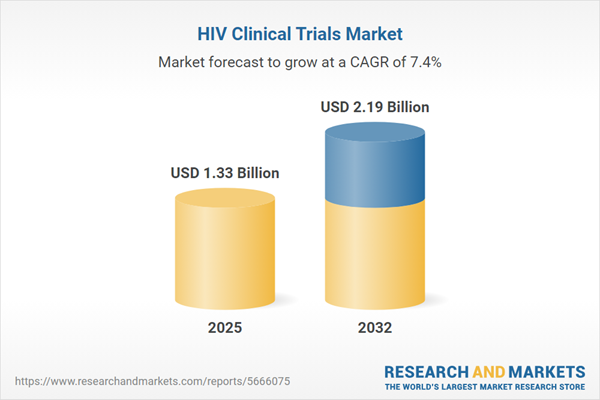Speak directly to the analyst to clarify any post sales queries you may have.
The HIV clinical trials market is navigating a period of rapid transformation as advancements in digital technology intersect with regulatory shifts. Senior executives must align compliance, digital integration, and adaptive research models to establish resilient strategies in a competitive global environment.
Market Snapshot: HIV Clinical Trials Market Overview
As of 2024, the HIV clinical trials market demonstrates resilient growth supported by ongoing investment and a marked shift toward patient-focused research. Leading industry stakeholders leverage new pharmaceutical technologies and enhanced digital trial platforms to address evolving research imperatives. The move toward flexible frameworks permits a more responsive approach, increasing the sector’s ability to meet a broad range of healthcare needs. Cross-regional partnerships and adaptive research models connect global standards with local context, refining outcomes through collaborative innovation. The continuous emergence of technology-driven solutions signals both adaptability and expansion opportunities across diverse research segments.
Scope & Segmentation of the HIV Clinical Trials Market
This report delivers a comprehensive view for executives aiming to refine their strategic approach in an evolving clinical research landscape. It offers targeted insights to improve decision-making and drive operational effectiveness across critical dimensions:
- Drug Class: Covers entry inhibitors, integrase strand transfer inhibitors, non-nucleoside reverse transcriptase inhibitors, nucleoside reverse transcriptase inhibitors, and protease inhibitors, each vital for protocol design and patient safety planning.
- Trial Phase: Encompasses early discovery, proof-of-concept, late-stage, and post-market surveillance cycles, supporting robust risk management throughout each step of clinical advancement.
- End User: Includes clinics, hospitals, academic centers, research institutions, and contract research organizations, ensuring inclusive stakeholder engagement and uniform research rigor.
- Route of Administration: Provides injectable, oral, and transdermal options, enabling custom trial designs to maximize patient reach and simplify enrolment processes.
- Distribution Channel: Incorporates hospital, online, and retail pharmacy pathways, all crucial for logistics management and consistent support across diverse study sites.
- Patient Age Group: Addresses strategies for adult, geriatric, and pediatric patients, promoting inclusive, age-tailored trial protocols for distinct clinical objectives.
- Geographies Covered: Spans Americas, Europe, Middle East & Africa, and Asia-Pacific, delivering detailed views on compliance trends and region-specific regulatory considerations.
- Key Companies Profiled: Profiles Gilead Sciences, ViiV Healthcare, Merck & Co., Johnson & Johnson, Roche, Pfizer, AbbVie, Sanofi, Moderna, and Takeda, all setting benchmarks for sector innovation and operational effectiveness.
Key Takeaways for Senior Decision-Makers
- Integrating adaptive trial methodologies enables swift responses to shifting patient needs and diverse operational environments, enhancing organizational flexibility.
- Expanding the use of digital technology and advanced analytics strengthens transparency and drives evidence-based oversight throughout all research processes.
- Greater collaboration among pharmaceutical, technology, and research entities accelerates the development pipeline and aligns trial innovation with industry demands.
- Staying ahead of evolving regional regulations ensures sustained compliance and facilitates seamless transitions within complex global regulatory settings.
- Adopting decentralized and digitally enabled trial models promotes broader patient participation and reliable data collection across multicenter and international studies.
Tariff Impact on Stakeholder Strategies
Anticipated U.S. tariffs in 2025 are encouraging companies to revaluate procurement processes and bolster supplier alliances. These developments have introduced more robust regional sourcing and deeper engagement with local contract research organizations to safeguard supply chain resilience and ensure uninterrupted trial activity. Ongoing coordination between logistics partners and regulatory agencies is fundamental to risk management and continued compliance amidst dynamic tariff policies.
Research Methodology & Data Sources
This report bases its conclusions on thorough literature reviews, systematic analysis of clinical trial databases, and confidential interviews with experienced leaders in healthcare and pharmaceuticals. Supplementary regulatory studies and scenario-based financial modeling further underpin the regional insights necessary for informed benchmarking and strategy development.
Why This Report Matters
- Equips executive teams with actionable, technology-driven insights to elevate clinical trial oversight and strengthen operational results.
- Guides leadership through complex regulatory challenges while uncovering opportunities for expansion in leading and emerging research markets.
- Provides strategic intelligence designed to optimise trial management, foster collaboration, and ensure sustainable market positioning.
Conclusion
Organizations that foster flexible leadership and targeted digital integration are best positioned to overcome sector challenges. Embracing adaptability and a data-first mindset ensures ongoing research excellence and business growth within the HIV clinical trials landscape.
Additional Product Information:
- Purchase of this report includes 1 year online access with quarterly updates.
- This report can be updated on request. Please contact our Customer Experience team using the Ask a Question widget on our website.
Table of Contents
3. Executive Summary
4. Market Overview
7. Cumulative Impact of Artificial Intelligence 2025
Companies Mentioned
The companies profiled in this HIV Clinical Trials market report include:- Gilead Sciences, Inc.
- ViiV Healthcare Limited
- Merck & Co., Inc.
- Johnson & Johnson
- Roche Holding AG
- Pfizer Inc.
- AbbVie Inc.
- Sanofi S.A.
- Moderna, Inc.
- Takeda Pharmaceutical Company Limited
Table Information
| Report Attribute | Details |
|---|---|
| No. of Pages | 184 |
| Published | October 2025 |
| Forecast Period | 2025 - 2032 |
| Estimated Market Value ( USD | $ 1.33 Billion |
| Forecasted Market Value ( USD | $ 2.19 Billion |
| Compound Annual Growth Rate | 7.4% |
| Regions Covered | Global |
| No. of Companies Mentioned | 11 |









